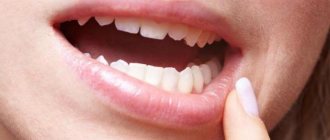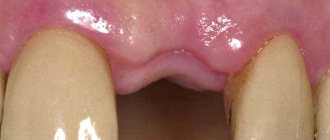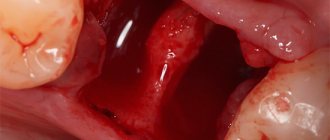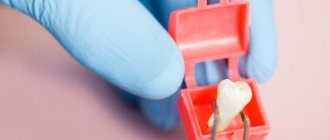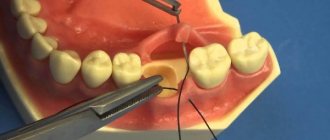Elimination of the eighth molar is a medical intervention that requires experience from the surgeon. Especially when the tooth is at an angle or has not come out completely. After a wisdom tooth has been removed, how long the gum tissue and jaw will hurt depends on a whole range of factors.
Can there be pain during surgery?
There are 2 types of procedures: simple and difficult. “Eights” are almost always included in the category of severe cases, since they have an unusual position and deep, tangled roots. If simple incisors and molars are removed only for serious indications - deep caries, suppuration - then in the case of “eights” this list is much wider.
The operation is performed only under local anesthesia. In severe cases, general anesthesia is recommended, but usually this operation is recommended for purulent tissue inflammation.
Modern drugs are used for pain relief: Ultracain, Septanest, Ubestezin. They are characterized by the ability to freeze bones for 1-2 hours.
Medicines like “Lidocaine” are obsolete and are used only for local anesthesia of the gums (in the form of a spray). However, the effectiveness of any drug depends on the characteristics of the patient’s body and his pain threshold.
Even with multiple injections of Ultracaine, severe pain may occur during the procedure. They are usually associated with the duration of the operation of 2-3 hours, a deep incision in the gum, and expansion of the bone socket. The patient experiences discomfort when cutting the tooth root and extracting it.
Features of tissue overgrowth
The patient cannot always tell how much the gums hurt after the removal of a wisdom tooth, since the intensity of the sensation may vary depending on the stage of tissue restoration:
- after cutting, an enlarged hole appeared;
- in the first hours after the intervention, it fills with blood, which then hardens;
- the resulting clot reliably protects the wound from bacteria;
- healing lasts from 3 days, depending on the method of removing the damaged wisdom tooth.
If a molar is pulled out the first time, the damaged area will hurt intensely for at least 3-5 days. By the end of this period, the damaged area will be almost completely healed.
But if the doctor made deep incisions and sutures, this time increases to 2-3 weeks. And soft and hard tissue will hurt for at least a month. The intensity of sensations will decrease every day. With prolonged recovery, bacteria can enter the wound, which will cause suppuration. Against this background, various complications arise.
How long does your gum hurt after wisdom tooth removal?
How many days the gums will hurt after wisdom tooth extraction largely depends on the skill of the doctor and the patient’s medical history. If the dentist performed all the manipulations and no complications arose after them, then the discomfort decreases after three days.
How long the discomfort will be felt depends on the condition of the soft tissues near the wisdom tooth, its shape and direction of growth. But it usually takes about a week to forget about the problem.
There are cases when a wisdom tooth continues to hurt for a very long time - if it had to be hollowed out in pieces or the roots removed from deeply dissected soft tissues. After this, sutures are placed on the surface of the wound, which gradually dissolve on their own.
In case of complex removal, no dentist can make an accurate prognosis. This period can last from a week to a month, depending on the pain threshold and complexity of the operation.
What to do if the pain returns?
If, after the removal of a wisdom tooth, the pain returns and becomes stronger after 5-7 days, then this is a sign of the development of a complication. If the sensations were not intense immediately after the operation, but intensified after 12-16 hours, this is a normal condition. The local anesthesia simply stopped working.
Recommendations during the recovery period
To avoid complications and reduce pain after wisdom tooth removal, you must adhere to the following recommendations:
- The gauze swab, which is placed in the hole after tooth extraction, must be kept for at least half an hour - during this time a blood clot will completely form in the cavity.
- After surgery, you should not eat or drink hot drinks for 3 hours.
- It is unacceptable to touch the hole with your hands or tongue, remove a blood clot, or rinse your mouth for 24 hours after the intervention.
- You cannot apply a cold compress to the cheek on the side of the extracted tooth to eliminate swelling - it will soon disappear on its own. Moreover, it is unacceptable to warm up painful areas - this can lead to the development of inflammation and the accumulation of pus.
- During rehabilitation, you cannot visit the bathhouse, sauna, or take hot baths.
- You should not eat spicy, salty, peppery foods or any foods that irritate the gum mucosa.
- Try to breathe only through your nose, as pathogenic microbes can easily penetrate into the wound through an open mouth along with the flow of air.
- For the first time after surgery, it is recommended to eat soft, smooth food - puree soups, semolina porridge, jelly, kefir, so as not to injure the damaged tissues.
- During the recovery period, try to quit smoking and drinking alcoholic beverages.
Pain associated with complications
If the gums in the area of the removed molar are subject to aching pain that occurs suddenly and is replaced by “shooting” attacks, and anti-inflammatory painkillers do not help, complications can be suspected. Postoperative pain usually appears with pathologies:
Sharp edges of the alveoli . Appear during a traumatic intervention. The pain intensifies when chewing and appears on the 2-3rd day.
Nerve neuropathy . Sometimes the roots of the teeth reach the facial nerves, and after removal they become irritated. When exposed, the lip or chin becomes numb, and acute pain appears in the entire lower jaw.
Exposure of the alveoli . Occurs as a result of injury that exposes an area of bone. Pain appears after eating hot food and drinks, as well as when pressing with a finger or instrument.
Alveolitis. One of the most common consequences of eliminating the “eight” is characterized by acute inflammation of the hole. Severe pain and foreign taste appear. Causes: incomplete bone removal, infection. May occur due to premature elimination of a blood clot and exposure of bone tissue.
Sometimes pus appears on the blood clot. In this case, you should immediately contact your dentist. Pus usually appears due to insufficient bone removal or untreated caries.
Periostitis . A rare pathology after wisdom tooth removal, due to which the damaged area can be very painful. Appears as a result of improper processing of dental instruments, with remaining tooth fragments. Additionally, severe swelling of the face, neck, chin, and mouth appears. Headache and fever occur.
Osteomyelitis . A dangerous stage of advanced periostitis. Gum tissue begins to die; if left untreated, the pathology affects the lower jaw bone and even the bone marrow. The pain is unbearable, NSAIDs do not help.
The patient experiences a pronounced nausea reflex, severe vomiting, and distinct swelling occurs.
Paresthesia . A rare consequence of tooth extraction, in which the wound will hurt slightly, but there will be numbness of the tongue, lips and cheeks. The patient loses normal diction. But usually recovery occurs on its own after 1-2 weeks (the doctor prescribes injections of Dibazol, Galantamine).
Bleeding . The most common complication after the removal of an incorrectly positioned wisdom tooth, which is combined with persistent pain. It occurs due to damaged blood vessels, violations of regulations, mechanical damage, and also due to hypertension. If there is bleeding, you should definitely visit the dentist.
Sometimes dry socket syndrome occurs as a result of the use of anesthetics and drugs to narrow blood vessels. Due to the spasm, a blood plug does not appear, and gum healing is delayed.
When the pain goes beyond the norm
Long-term pain in the gums, lasting more than 7 days, itching in the mouth, increased body temperature and changes in facial configuration indicate serious complications after extraction of the third molar. To eliminate signs of inflammation, you first need to find out why your gums hurt.
The main causes of pain after wisdom tooth removal include:
- Excessive trauma to the gums during extraction.
- Damage to the trigeminal nerve.
- Failure of medical personnel to comply with the rules of asepsis and antisepsis.
- Inflammation of the tooth socket due to the active activity of pathogenic microflora in the mouth.
- Failure to comply with postoperative recommendations.
Surgeon's mistake during wisdom tooth removal
The human factor, malfunction of medical equipment and the complex anatomical structure of the tooth can provoke a medical error. The appearance of aching pain in the gums due to the “flaws” of the dentist is caused by:
- incorrectly chosen treatment technique;
- leaving parts of the root and the source of infection in the wound;
- complex tooth extraction without water cooling of the pulp and soft gum tissue;
- the use of aggressive antiseptics when washing the hole;
- use of non-sterile instruments and dressings.
If the gums are swollen after tooth extraction and a blood clot does not form in the first hours after treatment, we can say with certainty that a medical error has occurred.
Alveolitis or inflammation of the socket
Alveolitis is a bacterial or fungal infection in the socket and surrounding tissues. In 70% of cases, the disease is accompanied by injury to the alveolar process of the jaw.
The causes of inflammation of the wisdom tooth socket include:
- infection during removal;
- the presence of bacterial plaque and dental deposits on adjacent teeth;
- ignoring the recommendations of the attending physician.
With alveolitis, patients complain of unbearable pain in the gums, swelling and bad breath. Possible deterioration in general health and loss of appetite.
Trigeminal nerve injury
A lateral X-ray of the jaw taken before wisdom molar extraction reduces the risk of damage to the trigeminal nerve. But if this stage of diagnosis was skipped and the doctor pulled out the wisdom tooth with sudden movements, the possibility of injury to a large cranial nerve and the appearance of severe pain during the rehabilitation period increases.
Symptoms of neuritis are spontaneous, radiating pain. The swollen gums at the site of damage may turn white, the lips and vestibule of the mouth become numb, and the tactile and taste sensitivity of the tongue disappears.
Most often, trigeminal neuritis occurs after removal of the lower eights, rather than the upper ones. Damaged white gums are treated with internal and local medications. Pain relief is carried out with analgesics.
Flux after wisdom tooth removal
Flux refers to the formation of pus inside periodontal tissue. The factor that provokes the disease after the removal of a wisdom tooth is the vital activity of pathogenic microflora in the wound and the oral cavity itself.
When inflammation occurs, the gums ache for a long time, a seal forms on the buccal side of the alveolar process, nearby lymph nodes become enlarged, and health worsens.
What to do to prevent consequences?
To prevent pain after wisdom tooth removal, and to avoid dangerous complications, doctors give detailed recommendations to the patient. The main one is taking certain medications and following a diet.
Medicines for complications
After any form of surgical removal of the eighth tooth, certain groups of drugs are prescribed.
It is important to carefully monitor your condition during the first hours after the surgical procedure. At this time, the risk of complications as a result of the rapid development of infections is high.
What to do after dental surgery?
To reduce the period during which the area of the removed molar will hurt, as well as to protect against complications, it is necessary to behave correctly.
Gauze swab . Immediately after a wisdom tooth is extracted, the doctor uses a tampon on the damaged area to stop bleeding. You need to remove it from your mouth as quickly as possible, since blood is the first source of infection. It should be removed carefully, not with a jerk upward, but with a slow sideways movement.
Make sure that there is no blood clot left on the tampon, which should close the wound hole. If the blood is still bleeding, make a new tampon from a sterile bandage and take a bite. It is not necessary to spit saliva into which the ichor gets into after the hole has healed.
Food after wisdom tooth extraction . You can eat soft food 2 hours after dental removal of a wisdom tooth. But you cannot chew on the area of the removed molar. During the first 3-5 days, it is advisable to eat only soft, twisted and pureed foods, preferably boiled or stewed. Solid food can injure the gums, and the area of the sutures and sockets will hurt.
Use a cold compress for swelling . After returning home, apply ice or frozen vegetables to the side from which the wisdom tooth was removed. The item must be wrapped in towels. Severe swelling prevents wound healing. Ice is applied according to the following scheme: every 10 minutes for 3-4 minutes for 3-4 procedures. It is impossible to warm up the damaged area, this causes inflammation and suppuration.
Immediately after removing the “eight” you should not smoke; it is advisable to give up tobacco for 2-3 days. Nicotine causes severe cramping, which interferes with healing. The same goes for alcoholic drinks. Their use is contraindicated during the day. If the doctor prescribed antibiotics, then you should not drink it for at least 5-7 days.
Rinsing is the best way to prevent
To prevent pain after wisdom tooth removal, you should use useful mouth rinse recipes. It is not recommended to brush your teeth intensively for 2-3 days, but decoctions will help get rid of infections.
Prepare solutions from water at room temperature to prevent hypothermia and burns.
To rinse, just put 50 ml of product in your mouth. The compounds should not be overused, otherwise they will disrupt the healing process. Use chamomile decoction prepared according to the instructions on the package (strain so that particles of the herb do not get into the wound). The recipe will relieve inflammation and destroy bacteria.
Baking soda also helps, but should not be used more than 2 times a day. A drop of iodine will enhance the effect: mix 1 tsp. salt and the same amount of soda, add 1 drop of iodine, rinse your mouth with a warm mixture.
A decoction of sage , boiled in a water bath, will relieve swelling and inflammation. A chlorhexidine solution will destroy all bacteria. It is prepared from 20 ml of antiseptic and 0.5 cups of water.
A composition based on mountain mumiyo . The drug strengthens the immune system, accelerates tissue healing and relieves pain. For 1 g of substance take 150 ml of warm water.
Recommendations after tooth extraction surgery.
The main recommendations in brief:
Tooth extraction is a surgical procedure aimed at removing a tooth or its roots from the jawbone. Thanks to modern methods of pain relief, this manipulation is rarely accompanied by painful sensations. However, even with the simplest tooth extraction, trauma to the tissues surrounding it occurs. In most cases, it is the degree of trauma that determines how pronounced and uncomfortable the healing period will be.
Most often, healing occurs almost unnoticed by the patient - discomfort can only be caused by the effects of anesthesia, which disappear within 24 hours. If a soft tissue injury occurs, you may experience minor pain for a few days. If the bone was damaged during removal, discomfort and pain can be quite long - 7-10 days. When the socket becomes infected (alveolitis), pain appears, which, if left untreated, can be very pronounced and persist for a long time. During the development of infectious inflammation in the hole, the surrounding soft and hard tissues are destroyed, causing the formation of pus and an unpleasant odor.
Please read the recommendations, following which will help you avoid unwanted consequences or reduce their manifestations:
1. Numbness from anesthesia.
Numbness from the anesthesia is normal. Sensitivity usually returns within a few hours. Avoid biting your cheeks, tongue, or lips until the anesthetic wears off.
2. Pain.
The pain intensifies as the anesthetic wears off. The severity of pain depends on the volume and duration of surgery and the individual characteristics of the body. In international practice, the following are usually prescribed for pain relief: - for mild pain: Ibuprofen, Paracetamol, Acetylsalicylic acid; - for moderate and severe pain: a combination of Ibuprofen and Paracetamol, Rofecoxib, Ketoprofen; - for very severe pain: narcotic analgesics, a combination of Ibuprofen and Paracetamol. Remember that only a doctor prescribes the drug and its dosage.
3. Blood clot.
After a tooth is removed, a blood clot forms in the socket - this is an integral part of the normal healing process. Actions that could damage the clot should be avoided. Recommendations to protect the blood clot: - Avoid smoking, harsh spitting, vigorous rinsing, and drinking through a straw for 24 hours after tooth extraction. These actions create a vacuum effect in the oral cavity and damage the clot, which impairs healing. — For 24 hours after tooth extraction, do not drink alcoholic beverages or use mouth rinses containing alcohol. — On the day of extraction, do not brush the teeth located next to the socket with a toothbrush. In other areas of the mouth, teeth should be brushed as usual. After brushing your teeth, rinse your mouth gently. — Try to avoid activities that require intense physical exertion for 24 hours after tooth extraction. This will eliminate surges in blood pressure and reduce bleeding, which will create more favorable conditions for the formation of a blood clot. - In some cases, the clot may collapse or not form at all. This condition is called alveolitis or “dry socket” and can be accompanied by severe pain, which you should definitely inform your dentist about. In such cases, additional therapeutic procedures are required.
4. Bleeding.
A sterile gauze pad may be placed over the socket of the extracted tooth to stop bleeding and protect the blood clot. This roller must be kept in the mouth for 20–45 minutes. Do not chew it or take it out prematurely. After its removal, minor bleeding may resume, in which case follow these recommendations: - During the first 24 hours, the color of the saliva may change due to mixing with blood. This is not dangerous and no action needs to be taken. — If there is severe bleeding, you can make a roll yourself from a sterile bandage. Moisten it with a weak saline solution (preferably well cooled), squeeze the gum around the socket with a roller and bite firmly for 10-20 minutes. The bleeding should stop. — Refrain from rinsing your mouth frequently—the bleeding may not stop, which will slow down healing and increase pain. — On the first day after removal, it is recommended to sleep on a high pillow. - If the bleeding does not stop on the second day or is very pronounced, immediately consult a doctor for examination.
5. Edema.
After tooth extraction, swelling may develop. This is a normal reaction of the body to surgery. A cold compress can help reduce swelling and pain. After simple extractions, ice does not need to be used; in more complex cases, an ice pack or a cloth moistened with cold water must be applied to the cheek on the side of the extraction. Use ice with caution—extreme cold can increase pain and delay healing. Keep the cold on your cheek for no more than 3-5 minutes, then rest for 3-5 minutes. After 3-4 compresses, you need to take a break for 1-1.5 hours. Cold is effective in the first 10–12 hours - after that its use is practically useless.
6. Medicines.
If you are prescribed medications to relieve pain and prevent the development of infectious complications, please use them after reading the instructions. Even if the painkiller prescribed to you does not have a sufficient effect, you cannot independently increase the dosage or shorten the intervals between doses of the drug. Do not make your own decisions - consult a dentist.
7. Hygiene.
Cleanliness in the oral cavity is the key to successful treatment. A clean wound heals better and faster. — Avoid brushing the teeth adjacent to the socket on the day of extraction. Teeth cleaning in other areas of the mouth should be done thoroughly using a brush and floss. In addition, it is necessary to clean your tongue. This will eliminate the bad breath and taste that often occurs after tooth extraction. - On the day of removal, carefully rinse your mouth with warm (in case of bleeding - cold) salted water (half a teaspoon of salt per glass of boiled water). Gently and carefully rinsing the mouth after each meal allows you to remove any remaining food from the socket. Do not use special mouth rinses until your dentist allows you to do so.
Read also: Should wisdom teeth be treated?
8. Diet.
— After tooth extraction, it is recommended to drink plenty of fluids and eat soft, high-calorie foods. — Avoid drinking hot and alcoholic drinks. - Avoid eating spicy, salty, sour and hot foods. — It is advisable to start eating solid food the next day after removal or, in extreme cases, after the anesthesia wears off. For the first few days after tooth extraction, try to chew on the side of your mouth opposite the socket. After restoring a comfortable state, you can return to normal chewing.
9. Physical activity.
On the day of surgery, it is necessary to reduce physical activity to a minimum. Increased physical activity and sports stress can cause throbbing pain, bleeding and dizziness. Be extremely attentive to your feelings, be prepared to interrupt physical activity at any time.
What not to do after surgery
Dentists prohibit certain things from being done after wisdom tooth removal. If you do not follow the recommendations, the area of intervention will not only hurt, but will be accompanied by complications:
- you cannot bathe in a hot bath for 2 days;
- It is forbidden to go to the sauna and swimming pool for a week;
- you cannot pick at the wound with your tongue or objects;
- heavy physical labor is prohibited;
- You can’t open your mouth wide;
- It is forbidden to take aspirin for pain relief, as it thins the blood;
- rinsing the mouth should be moderate; intensive process slows down healing.
Dentists recommend suturing. This process ensures that the tooth hurts half as much and the blood clot under the stitches is protected from falling out.
Even if wisdom tooth removal is simple, ask the surgeon to apply 1-2 stitches to prevent complications.
Tooth extraction: swelling
Tooth extraction is a difficult operation that traumatizes the tissue surrounding the tooth. Therefore, it is not surprising that unpleasant consequences occur after tooth extraction: the most common of them is swelling. Patients often complain that after tooth extraction, the gums become swollen, swelling of the cheek or a slight gumboil appears. This is caused by partial destruction of the soft tissue around the tooth. This is unpleasant, but if the tumor is small, it goes away on its own in 2-3 days. To relieve swelling after tooth extraction, ice can be applied to the cheek for about 10 minutes. If the swelling has not gone away after a day, apply heat. Keep the heating pad for 20 minutes, then take a break for 10 minutes and put the heating pad back on.
Sometimes swelling can be caused by an allergy to the anesthesia. In this case, histamine, an antiallergic drug, will help. But if the swelling increases, then it may be a sign of inflammation that has arisen after tooth extraction. In this case, you should immediately consult a doctor.
Advice for people with hypertension and diabetes
To prevent unpleasant processes after molar removal, take medications that lower blood pressure if you suffer from hypertension. In case of high blood pressure, the risk of bleeding and hematomas increases significantly. In the first case, there is a risk of eliminating the blood clot ahead of time, and in the second, a complication in the form of suppuration is possible.
If you have diabetes, it is recommended to bring your glucose levels back to normal. The adrenaline rush that occurs during surgery can cause blood sugar spikes. Against this background, the patient’s health deteriorates significantly.
What to do to reduce pain
In some cases, the pain can be quite intense and it is extremely difficult for the patient to endure it. Therefore, after removal, the dentist may prescribe various painkillers to alleviate the general condition.
To relieve toothache, non-narcotic analgesics are used, most of which have an anti-inflammatory effect. Such medications include: Ketanov, Nimesil, Nurofen, Iburofen, Movalis, Analgin.
It is important to remember that painkillers affect all organs and systems and can cause various side effects. It is recommended to stop taking such drugs as soon as the intensity of symptoms decreases. And it is worth remembering that only a doctor can prescribe such medications.
You can also apply cold compresses to the cheek area for the first few hours after wisdom teeth removal. The use of this method allows you to get rid of unpleasant sensations and promote the speedy healing of wounds.
Decoctions of medicinal plants contribute well to wound healing. To prepare, you need to make a decoction of St. John's wort or chamomile and leave for a little while. You should not rinse your mouth because it may wash out a blood clot from the socket of an extracted tooth. Instead of rinsing, you just need to put a decoction of herbs in your mouth and hold it for a while, then spit it out.
You can take antihistamine medications. With their help, the effect of painkillers is enhanced and swelling is reduced. In addition, these medications have a hypnotic and sedative effect.
Removal of sutures and future dental treatment
Modern dentistry offers the use of threads for sutures that dissolve themselves. If regular threads were used, the sutures are removed on days 7-8 in the absence of complications. In this case, self-absorbing materials are eliminated on days 9-11.
In difficult situations, it happens that after the removal of a wisdom tooth, additional treatment of the remaining molars is required. It is prescribed no earlier than 7 days after pulling out the “eight”. In case of complex removal, additional therapy is postponed for 2-3 weeks.
It is impossible to treat teeth before the specified period, since in the presence of caries there is a high risk of infection of the wound, which has not had time to heal completely.
After wisdom teeth are removed, the socket will always hurt. How long the sensations last depends on the presence of complications and the type of intervention. With normal healing, the pain stops within 5-7 days. In case of a complex operation, the period increases to 10-14 days.
Specifics of the problem
It has been scientifically proven that the final formation and growth of the body is completed by the age of twenty-five. Moreover, two pairs of third molars may appear much later, already in adulthood, when the bones have already become stronger and have lost elasticity. This factor causes the problem of normal growth and development of these rudimentary teeth. Often there is not enough space for them to take a normal position in the dentition. Of course, their appearance threatens the destruction of neighboring healthy molars. This becomes the reason for the frequent decision to get rid of eights.
The need to remove wisdom teeth is due to their inability to occupy a normal position in the dentition
However, the troubles do not always end there. Given the complexity of their location and the high likelihood of internal destruction, manipulation often becomes a rather complex procedure. Of course, this entails certain complications. After all, you can often hear: your wisdom tooth has been removed, your gums hurt, or other similar statements. Therefore, let’s analyze why difficulties arise and how we can cope with them.
Usually, if you have a wisdom tooth pulled out, how long the operated area will hurt depends on the nature of the placement of the molar. Eights growing at an acute angle or horizontally often cause very traumatic removal, which can result in damage to the mucous membrane of the gums or other teeth. In addition, if oral sanitation is insufficiently observed, purulent inflammatory processes are possible.
How many days the pain lasts after wisdom tooth removal may also depend on the area where the manipulation was performed. As practice shows, upper teeth are usually not as difficult to extract as lower teeth. Indeed, in these situations, the doctor has a better viewing angle and is provided with a normal approach to the desired area.

